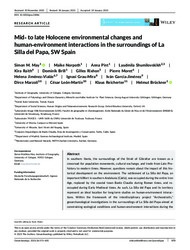Mid‐ to late Holocene environmental changes and human‐environment interactions in the surroundings of La Silla del Papa, SW Spain
Norpoth, Maike
Shumilovskikh, Lyudmila
Raith, Kira
Rixhon, Gilles
Moret, Pierre
Jiménez‐Vialás, Helena
Grau‐Mira, Ignasi
García‐Jiménez, Iván
Marzoli, Dirce
León‐Martín, César
Reicherter, Klaus
May, Simon M.; Norpoth, Maike; Pint, Anna; Shumilovskikh, Lyudmila; Raith, Kira; Brill, Dominik; Rixhon, Gilles; Moret, Pierre; Jiménez‐Vialás, Helena; Grau‐Mira, Ignasi; García‐Jiménez, Iván; Marzoli, Dirce; León‐Martín, César; Reicherter, Klaus; Brückner, Helmut, 2021: Mid‐ to late Holocene environmental changes and human‐environment interactions in the surroundings of La Silla del Papa, SW Spain. In: Geoarchaeology, Band 36, 4: 573 - 600, DOI: 10.23689/fidgeo-4367.
 |
Dokument öffnen: |
In southern Iberia, the surroundings of the Strait of Gibraltar are known as a crossroad for population movements, cultural exchanges, and trade from Late Prehistory to modern times. However, questions remain about the impact of this historical development on the environment. The settlement of La Silla del Papa, an important hillfort in southern Andalusia (Cádiz), was occupied during the entire Iron Age, replaced by the coastal town Baelo Claudia during Roman times, and re‐occupied during Early Medieval times. As such, La Silla del Papa and its territory represent an ideal location for long‐term studies on human‐environment interactions. Within the framework of the interdisciplinary project “Archeostraits,” geoarchaeological investigations in the surroundings of La Silla del Papa aimed at constraining ecological conditions and human‐environment interactions during the mid‐ and late Holocene and during major human occupation phases. Our results document an early mid‐Holocene marine embayment in the lower floodplain of the Río del Cachón, rapidly turning into a coastal lagoon and later into freshwater‐dominated wetlands. After approximately 2100 BP (c. 150 BC), fluvial and alluvial deposition i600ing a high anthropogenic impact on the local landscape during Roman or post‐Roman times. Palynological results reveal fluctuating agricultural and pastoral activities and distinct periods of landscape opening during the Neolithic and Iron Age.
Statistik:
ZugriffsstatistikSammlung:
Schlagworte:
Archeostraits projectBaelo Claudia
coastal changes
La Silla del Papa
microfaunal investigation
palynological analyses
sea‐level evolution
soil erosion
Zahara de los Atunes
This is an open access article under the terms of the Creative Commons Attribution‐NonCommercial License, which permits use, distribution and reproduction in any medium, provided the original work is properly cited and is not used for commercial purposes.

